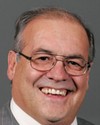Bon après-midi, monsieur le président, mesdames et messieurs les députés. Mr. Chairman, members of Parliament, good afternoon. Thank you for inviting me back to speak to the committee.
Accompanying me again this time is Rudy Kellar, Nav Canada's vice-president of operations, and Larry Lachance, the assistant vice-president, operational support.
In March, when I last appeared before the committee, we discussed the airport traffic services review that Nav Canada had initiated to examine service requirements at a number of airports. We are now undertaking extensive consultation with customers, employees, and community and other stakeholders on those proposed changes. These consultations will include the federal members of Parliament in whose ridings the airports are located. However, I understand from the clerk that the committee wishes to discuss Mirabel airport in particular today.
As you know, Mirabel airport has undergone a significant evolution in the past decade. Airport traffic has fallen by more than 40% since 2000, and passenger service ceased altogether in 2004. The airport operator has closed one of the two runways and is in discussions with a private consortium for the redevelopment of the terminal building into a theme park. Today the airport is primarily used by cargo operators, the aerospace manufacturing industry, and general aviation, including flight training.
As the committee is aware from our previous discussions, we review our levels of service regularly. It is good business practice and an integral part of our mandate that requires us to apply our level of service policy in a consistent manner.
Given the significant change in airport operations at Mirabel, we initiated an aeronautical study in July 2006 to examine our levels of service at that airport. Consultation and analysis were undertaken, and a completed aeronautical study was submitted to Transport Canada in May 2007.
The study recommended that the 24-hour airport control tower be replaced with a 24-hour flight service station. Transport Canada reviewed the study and indicated its concurrence in November 2007. Approximately one year later, on November 20, 2008, the service change was implemented.
Our services at Mirabel are in accordance with our published level of service policy, which we discussed in March. Among other things, the policy states that airport control towers are generally required when the sustained activity at an airport is above 60,000 movements annually. Flight service stations are generally required when an airport has more than 20,000 movements annually, of which about 7,500 are scheduled air carrier movements.
I have appended at the end of my printed remarks several graphs showing annual movements at the Mirabel airport in each year since 2000, hourly average movements, and 2008 movements plotted against our level of service assessment guidelines. At approximately 26,000 annual movements, traffic demand at Mirabel is appropriately served by a flight service station.
Flight service specialists are highly trained aviation professionals who provide safe and efficient operations at 58 airports in Canada, including some with complex traffic mixes and much greater traffic volumes.
You will have heard that some companies have expressed concern about the absence of a control tower at the airport. We have met with the companies in question twice in the past few weeks and will be meeting with them again later this week to discuss their issues and ways to mitigate them. One possible solution is for the companies requesting the control service to agree to pay for it. We estimate the cost at about $500,000 per year.
I can assure the committee that I fully recognize the importance of the aerospace manufacturing activity that occurs at Mirabel airport, and that our service assessment considered the uniqueness of Mirabel operations, where significant test flights originate and terminate.
Our flight service specialists provide excellent service to the aviation community. Their duties are comprehensive, and their track record in safety and service is exemplary. Rest assured that we are prepared to listen to and work closely with the customers and stakeholders involved to address the concerns that have recently been expressed.
With that, Mr. Chairman, we'd be happy to take the committee's questions.




